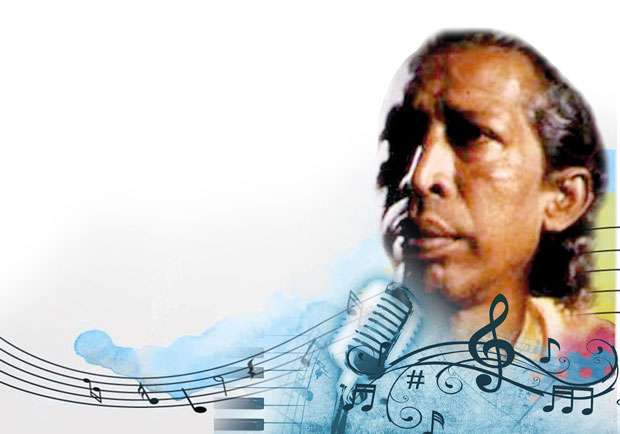20 Nov 2018 - {{hitsCtrl.values.hits}}

 Udena Wickremesooriya, talking about his father’s work, the evolution of Sooriya, and the resurgence and upsurge of popular music in this country during the latter part of the sixties, suggested that when compared to the deterioration on almost every front in the political sphere, contemporary artists, especially vocalists and composers, didn’t seem to rebel enough against the establishment. “Where’s our Arab Spring? Where’s our Pussy Riot? Where are our Nina Simones and Aretha Franklins?”
Udena Wickremesooriya, talking about his father’s work, the evolution of Sooriya, and the resurgence and upsurge of popular music in this country during the latter part of the sixties, suggested that when compared to the deterioration on almost every front in the political sphere, contemporary artists, especially vocalists and composers, didn’t seem to rebel enough against the establishment. “Where’s our Arab Spring? Where’s our Pussy Riot? Where are our Nina Simones and Aretha Franklins?”
It was not a lament. It was an observation. He did not regret, yet he was not happy either: “Music and politics can be strange bedfellows at times, but more often than not, the one complements the other.” He pointed at two frequently alluded to names: Nanda Malini and Gunadasa Kapuge. It’s impossible to rank them, and it depends on your preferences. I’m not sure how Udena would rank them, but as I would place Kapuge at the top. Not because Nanda, and Sunil Ariyaratne, were his inferiors, but because in Kapuge, if we are to take Udena’s word for it, we come across a near-perfect “complementarity” between music and politics.
Music and politics can be strange bedfellows at times, but more often than not, the one complements the other.” He pointed at two frequently alluded to names: Nanda Malini and Gunadasa Kapuge. It’s impossible to rank them, and it depends on your preferences. I’m not sure how Udena would rank them
Protest music, like protest plays and protest films, privileges the political over the aesthetic most of the time. This is known. The truly creative artiste, if he or she has engaged with his or her society well enough, knows how to craft the lyric, the melody, and the script in such a way that they do not become politically relevant at the cost of being artistically confused and clichéd. Some of the most seminal works of protest art I’ve seen or listened to over the last five years, here, have stood up to that test. That is why Udayasiri Wickramaratne’s Suddek Oba Amathayi is a greater political play than most of Rajitha Dissanayake’s newer plays. That is also why Jehan Aloysius’s Rag, an indictment (supposedly) on the politics of ragging, tends to negative and contradict its own message in a way that Jayantha Chandrasiri’s Hankithi Dahathuna does not, even though the latter is patently less political.
What is true for our plays is true also for our music. Pick on any theme: a mother’s love. One of the more popular songs delving into it from the recent past is Sixth Lane’s “Mandaram Wahi Watena”. It is moving in a populist way: its lyrics are not fragmentary like most contemporary songs, and it appeals to everyone. And yet, it shares with those songs one problem: a literal-minded approach to its subject matter.
Le kiri karapu amma senehen wadu mage amma
I am not, by any stretch of the imagination, an expert on the Sinhala language and its many poetic nuances, but I can’t help notice that whatever the theme, political or otherwise, most lyricists just can’t get beyond the immediacy of what they are asked to write about. If it’s love, we hear the inevitable lament: “I love her, she loved me, her father didn’t like me, she’s gone off with a richer man!” If it’s about the country, we hear the inevitable rallying cry: “Sri Lankaaaa mathaaaa!” (No offence to Bathiya and Santhush, of course.) We’ve banalised the lyrics, in other words, so much so that there’s nothing really left to read into them.
The situation is trickier for socially conscious songs, because no one bothers to sing about injustice, disparities, protests, and the brotherhood of man any more. They are content with aestheticising the personal. That’s it.
How different, then, are Kapuge’s songs! Kapuge did not sing about injustice and disparities and protests and the brotherhood of man only, though his more popular songs delve into these themes. He also sang about mothers who bring up fatherless children, of the bitterest and sweetest tear-drops of unrequited romances, of lovers who part ways in the twilight of their youth, and, soaring above them all, of the ula lena who, cast aside from this cruel world, seeks shelter in the thorny thickets of a forest. There was nothing he couldn’t sing about. Nothing he didn’t, either.
Who was he, then? He was many things. At one point, the voice of the Rajarata Sevaya, where he was sent packing off to, as a punishment transfer, when he was working at the SLBC. My mother and father heard him over the Sevaya, and for their generation at least, that was how he was best remembered. Karunaratne Divulgane, Jayathilake Bandara, Manel Rajakaruna, and Annesley Nanayakkara, on the other hand, will remember him as their teacher, the man who was able to spot out, choose, and nurture young, emerging talent. “He was a beacon of light,” Divulgane, speaking of the man, told Malinda Seneviratne. I’m sure there are others who remember him for other reasons. Like Sugathapala de Silva, whom I shall get to shortly.
As for me, I remember him more than anything else for one song. Well, two actually: “Dawasak Pela Nathi Hene” and “Dam Patin La Sanda Basa Yanawa.” The first is about reconciliation, the second about separation. The first is about the sorrow of love, the second about the happiness of parting. I heard them for the first time over the radio when I was young. They captivated me not on account of the words or the melody, but as importantly as both of them, the voice. Amaradeva’s songs belong to Amaradeva because no one else can (or should, as W. D. Ariyasinghe ought to have realised) sing them. It is the same with these two. They belong to Kapuge.
“Dawasak Pela Nathi Hene” is the best riposte I can think of to a banal song like “Mandaram Wahi Watena” because, strangely enough, both of them pick on the same trope: the mother as a shelter for her son. But while Sixth Lane’s ditty plays on a more literal interpretation of this troupe, Kapuge’s song plays on its symbolic value. The title itself brings together the literal and symbolic, a “pela nathi hena” being a metaphor for a mother who has lost her husband. Simple, yet profoundly unsettling.
I know of youngsters who cry at Sixth Lane’s song, and I know for a fact that they are sincere in their response to it. But try as I might, I can’t bring myself to weep to the literal mindedness of its lyrics. Can they really compare to the following lines?
Otunna bimada duwagena ennada eka pimme
Mang enathuru indikada langa innawada amme
It goes without saying that they cannot. Not because the lyricist of Sixth Lane’s song hasn’t tried, but because we are now used to being bombarded by the literal meaning of a work of art so much that we don’t even try to go beyond the first reading of a text. Popular culture has become a culture of literal artifice: it has no room for a Kapuge, because (and this is what musical connoisseurs and critics have told me) technology is far more alluring to the present generation of vocalists and lyricists than the fact that a song, like any other work of art, has to formalise an experience: not necessarily lived through perhaps, but still heard about, picked up, and relayed.
I heard Kapuge through many other songs. Right at the other end of the sorrowful overtones of “Dawasak Pela Nathi Hene” were the joyful undertones of “Dam Patin La Sanda Basa Yanawa”, which, like Kapuge’s lament for the mother, was also rooted in a personal experience (Lucien Bulathsinghala, who was the lyricist, tells us that he wrote it for a childhood lover who parted ways when he entered Peradeniya Campus and she entered Colombo Campus; Ranbanda Seneviratne, who wrote the other song, tells us that he wrote it as a tribute to his mother).
Those were more personal, though, and, by default, less political. They spoke to our innermost feelings, which bonded the rich to the poor, and the dispossessed to the privileged. You didn’t have to be anyone in particular to listen to, or enjoy, them.
There were other songs. These, I will get to later. For now I will say this: they enthral me less because they are interesting as works of art than because they were sung by a vocalist who remained, to his last day, a humanist. I mentioned Sugathapala de Silva before. Here’s how Sugathapala (whose “Thuranga Sanniya” became the first play that Kapuge scored) will remember him. I quote Malinda: “Kapuge had collected the payment for his part in the ‘Sunflower samaga (with) Kapuge’ album, a few hundred thousand rupees, and gone straight to visit a friend who was suffering from cancer and needed money for surgery/medication. He left the money with his friend. Then he went home. Simple.” That friend, of course, was Sugathapala.
There were so many stories like that about Kapuge. “A true artist becomes a human being first,” Victor Ratnayake once told me. Kapuge, in that sense, became a man, a human being, long before any of us picked him up at the Rajarata Sevaya. He didn’t leave us as an artist, though. Like Amaradeva, he lingers on. With us.
30 Nov 2024 2 hours ago
30 Nov 2024 3 hours ago
30 Nov 2024 4 hours ago
30 Nov 2024 6 hours ago
30 Nov 2024 9 hours ago